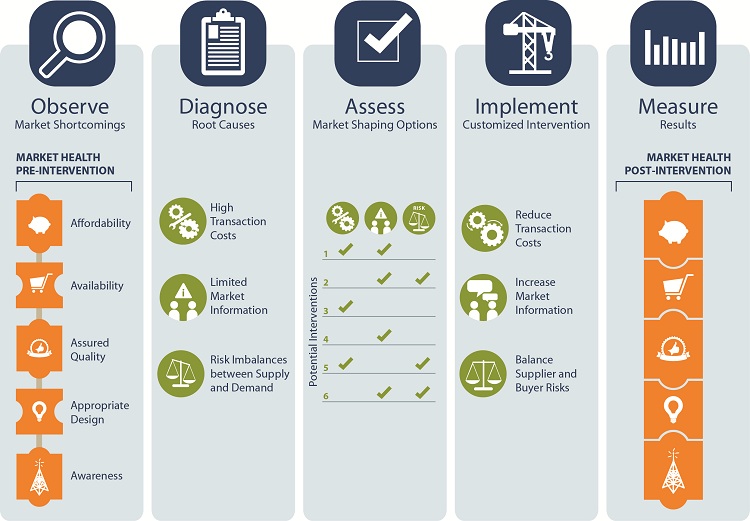Separating Potential from Panacea: USAID’s primer offers a disciplined approach to market shaping
Global health is inextricably linked to the health of the marketplace that delivers lifesaving products to low-income populations. A well-functioning health care market with public and private sector participation requires manufacturers to produce high-quality products, distributors to deliver the necessary quantities, providers to administer them correctly and patients to be educated and active participants in their own health.
However, markets sometimes fall short. Developers may not see enough demand to develop a new product, manufacturers may not know how much to produce and distributors may not see enough profit to justify delivery. A single breakdown in this complex, interactive system can keep lifesaving products from those most in need.
Actors at both ends of the market – producers and purchasers – may face high transaction costs, knowledge gaps or imbalanced risks that hamper their participation in the market and lead to market shortcomings. Countries, donors and procurers can use their purchasing power, financing, influence and access to technical expertise to address the root causes of market shortcomings and influence markets for improved health outcomes. By disrupting current practices or transforming market structures in this way, market shaping can achieve better health outcomes for the poor.
Designed to be transformative, market shaping has demonstrated its potential to enhance value for money, diversify the supply base, increase shipment reliability and ultimately increase access for end users. Between 2003 and 2013, GAVI strengthened the pentavalent vaccine market by increasing the number of suppliers and achieving price reductions, leading to a projected savings of up to $150 million and a more than tenfold increase in the number of children immunized.
In the HIV sector, the USAID-administered Supply Chain Management System established regional distribution centers that used demand forecasting and greater delivery efficiency to decrease costs and increase reliability – improving on-time deliveries in South Africa, for example, from 60 percent to 90 percent in four years (Larson, Burn, et al, “Mitigating Supply, Demand and Cost Risks in ARV Supply Chains”). The U.S. Food and Drug Administration helped expand the supply base for HIV drugs through its expedited drug review process, which enabled the U.S. President’s Emergency Plan for AIDS Relief (PEPFAR) to procure from more generic manufacturers for developing countries.
Drawing from these and other experiences in market shaping from across the vaccine, HIV, malaria, family planning and other health sectors, USAID’s Center for Accelerating Innovation and Impact (CII) in partnership with practitioners and experts outlined a “market shaping pathway.” Encapsulated in its recent report Healthy Markets for Global Health: A Market Shaping Primer, this disciplined approach consists of five steps for evaluating and implementing market shaping opportunities. Importantly, this pathway does not point to market shaping as a panacea to solve all market access issues within global health. Addressing all of these issues requires a multifaceted approach, and market shaping builds on a foundation of other critical global health efforts – from health care provider training to civil society engagement to product introduction planning – in order to succeed.

In the market shaping pathway, Step 1 is to observe market shortcomings that limit health impact. Market shortcomings could include a high product price; overreliance on a single supplier; cycles of shortages and gluts; prevalence of substandard products; ill-suited products; or low user interest in superior innovations. The Market Shaping Primer groups these and other market characteristics into the following mnemonic set of “5As”: Affordability, Availability, Assured Quality, Appropriate Design and Awareness.
Step 2 is diagnosing the root causes underlying these market shortcomings. A range of analytical tools can help examine market actors, their interactions or their regulatory systems to pinpoint whether root causes fall into one or more of the following three groups:
• High transaction costs
• Limited market information
• Risk imbalances between supply and demand
After tracing market shortcomings to their underlying root causes, Step 3 is to assess market shaping options. This is essentially a matchmaking operation between the market and its most appropriate market shaping intervention, if any. Each intervention should be evaluated against how it would address the root cause of the shortcomings and consider the benefits, drawbacks and implementation constraints.
Step 4 of the pathway focuses on implementing a customized intervention, recognizing that close collaboration with market actors is essential in undertaking complex, interconnected activities like market shaping. Similarly, practitioners should be mindful of any tradeoffs required, whether between competing objectives or execution styles, so these decisions can be made strategically and transparently.
In Step 5, the emphasis shifts to measuring results at the health output and health impact levels as well as the more immediate market level. In addition to providing valuable feedback on the intervention, this tracking can help practitioners quickly adapt the intervention to changing market and health conditions as needed.
These five steps of the market shaping pathway recognize that while market shaping can be transformative, it should be undertaken with rigorous analysis, careful preparation and close coordination. The Market Shaping Primer offers a disciplined approach to examining a health product market and evaluating whether and how market shaping could increase access for end users. Ultimately, the goal of the primer is to inform practitioners as they seek to catalyze health markets and enhance health impact in poor communities.
For more information, visit the USAID Center for Accelerating Innovation and Impact (CII) website.
Amy Lin is a senior market access advisor at USAID’s Center for Accelerating Innovation and Impact (CII), where she develops and implements market-based strategies for adoption of priority health solutions.
- Categories
- Health Care
- Tags
- governance, supply chains
